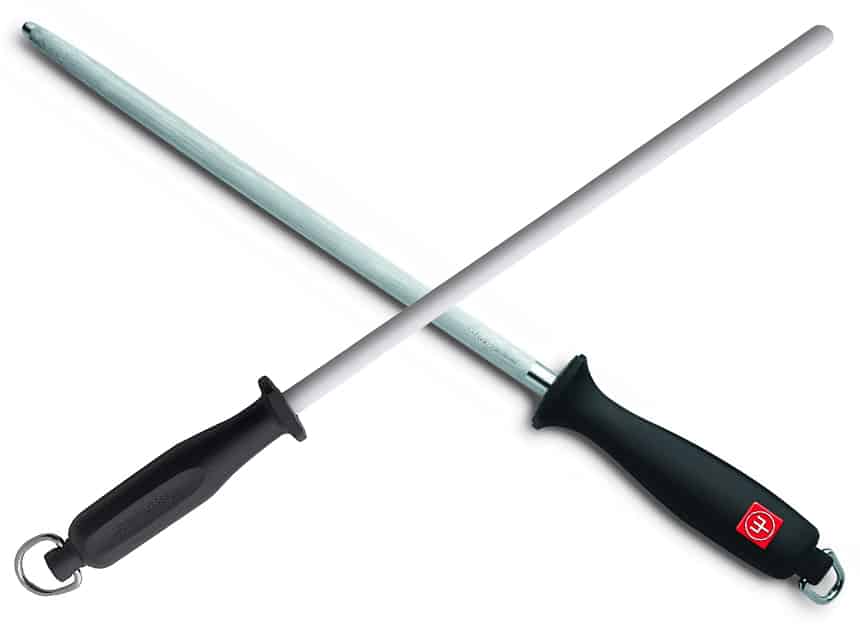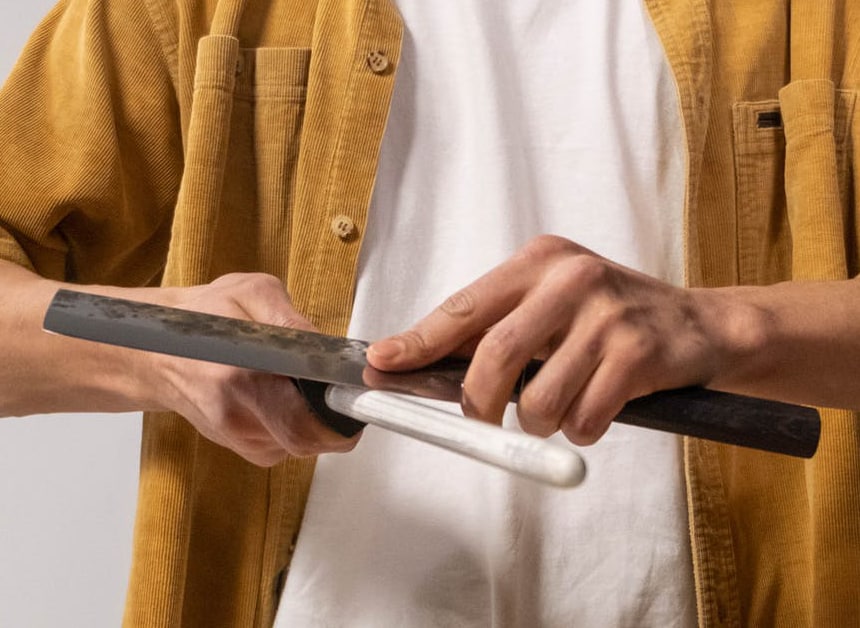
Keeping your kitchen knives well maintained is a very sensible idea, especially if you have invested a fairly large amount of money in a quality set.
Unfortunately, maintaining your knife has been made more complicated by very messy and misleading marketing techniques.
That’s probably one of the reasons why you’re here. To understand what the difference is between ceramic and steel honing rods so you can pick the one you need.
Well, it’s a good job you are here; because the difference is a big one.
Ceramic rods will not hone a knife at all, they will sharpen it. Alternatively, steel rods won’t sharpen a knife but will hone it. So which material you choose should be based on whether you need to sharpen or hone your knife.
If you’re not familiar with the difference between honing and sharpening then you’re not alone. Most home cooks don’t know the difference and that’s mainly because steel products are often mis-marketed as sharpening products when they are not.
So let’s begin by looking at the fundamental difference between honing and sharpening a blade.
The difference between honing and sharpening
Put simply, honing realigns the blade whilst sharpening removes a layer, to unveil a fresh, sharp layer.
So why this difference, aren’t we only interested in sharpening our knives?
Well… no, we’re not. Honing a knife is actually far more common than sharpening it and that’s why there’s so much confusion around the topic.
When you see chefs on TV rapidly passing their knife along a steel rod what they are doing is honing it. They may even say they are sharpening but they aren’t!
Honing a knife should be done quite often. Around every three uses of the knife at least.
If you zoomed in on a knife blade you would find that the edge is made up of tiny little teeth, like a serrated edge. It might not be visible to the naked eye but zoom in close enough and all knives have this serrated edge.
When you use a knife these ‘teeth’ will inevitably be bent slightly out of shape and thus the blade edge goes out of alignment.
So when you glide a knife blade along the edge of a honing steel, what you are doing is pushing the blade edge back into a straight alignment.
That will inevitably make the knife seem sharper but you haven’t actually removed any material.
You only ever need to truly sharpen a blade when it can no longer be satisfactorily realigned with a honing steel. That edge cannot be saved so now you need a new one.
So to sharpen, you need to use a material harder than steel. Otherwise, it won’t be able to remove any steel from your blade.
That’s why ceramic is used. Ceramic is very hard (but also quite brittle). Therefore; when you glide a steel blade along a ceramic rod, the harder ceramic removes a thin layer of the steel from the blade.
Effectively all of those bent out of line, microscopic teeth get removed from the blade, revealing a fresh new blade edge underneath.
Of course, you won’t want to actually sharpen your blade as often as you would hone it as sharpening is actually reducing the size of your knife (only by a tiny fraction each time).
Sharpening only needs to be done every 6 – 12 months, or longer if you don’t often use that knife.
So there you have it, the difference between honing and sharpening, a secret that so few people seem to be in on!
Now we know that we can easily understand whether we need a ceramic or steel rod.
Ceramic vs Steel Rod
Ceramic rod
- Used to sharpen a blade
- Only needs to be used infrequently (every 6 – 12 months)
- Very brittle to be sure to store it carefully
Steel rod
- Used to hone a blade
- Should be used very frequently (every 3 uses of the knife at least)
- Very strong, but it won’t technically sharpen your blade!
Do I need a ceramic or steel rod
Really, you need both. Or at the very least you need a steel rod for honing and then some other sharpening method.
The best sharpening alternatives are either a diamond rod or whetstones.
Diamond rods are like steel rods but encrusted in very fine diamond dust. Since diamond is harder than steel it can effectively sharpen a knife. However, as diamond is so very hard then it can sometimes be a little too abrasive on the steel, personally, I prefer ceramic rods as they are more gentle.
Whetstones are the best method, but they take the most time and dedication. They are abrasive, flat stones and come in different grits (that’s a measure of how rough the surface is).
Sharpening a knife on a whetstone is a little like using sandpaper to sand wood. You can begin with a low grit (or very rough) whetstone and then work up to a high grit (or very fine) whetstone and end up with an extremely sharp finish.
Whatever method you choose it is a good idea to have some kind of tool you can use to sharpen your knives. Just remember that it’ll only sharpen them if it’s made from a material harder than steel.
So if you see any kind of pull-through sharpener for a sharpening rod that’s made from steel, just be aware that it’s a marketing trick, these tools will only hone your knife, not sharpen them.
My honing steel recommendation

View on Amazon (opens new tab)
Honing and sharpening tools last for decades if they’re looked after properly. That’s why I would always recommend you invest in one of decent quality.
A poor quality honing rod runs the risk of damaging your knife, so if you choose a quality honing rod then there’s a good chance your knives will last longer too.
This 10-inch honing rod from Wüsthof is the only steel you will ever need. Wüsthof are renowned for their high-quality western knives, so this is the perfect kitchen partner.
My ceramic rod recommendation

View on Amazon (opens new tab)
A ceramic rod would be my go-to choice of sharpener.
They are quick and easy to use and they aren’t too abrasive on the blade steel, so it’s pretty hard to make any mistakes when sharpening with a ceramic rod.
On the downside, ceramic can be very brittle so you just need to make sure you store it carefully, somewhere it won’t get knocked around.
Messermeister make some of the most beautiful chef’s knives you can buy. It’s a brand that oozes with quality and their ceramic sharpening rod is no different, it’s an absolute bargain for the quality you get.
My diamond rod recommendation

View on Amazon (opens new tab)
Be careful with diamond rods. Personally, I prefer ceramic because they are more gentle. Diamond is extremely hard so it can be very abrasive.
On the plus side though a diamond rod is not brittle like a ceramic one. So it can withstand being knocked around in the kitchen.
So if you have a busy kitchen with cutlery drawers being slammed and utensils being thrown into the sink (I’m thinking of a typical family kitchen here!) then a diamond sharpener might be the best way to go.
If you’re buying a diamond sharpener then it needs to be quality. The cheap ones have rough edges and can tear up your steel. It’s hard to find better quality than from the always top-notch Wüsthof company.
My whetstone recommendation

View on Amazon (opens new tab)
This is undoubtedly the best way to get a sharp finish to your knife but it takes a little more work.
In reality, though you only need to sharpen your knives every 6 months to a year, and that’s just the ones you use on a frequent basis.
So taking 20 minutes one weekend to properly sharpen them isn’t too much of a chore for the significantly better results you can get.
This great set from AHNR contains all the different grit of whetstones you will ever need. You can get a pretty good finish from the 1,000 grit alone.
Once you start going to the 3,000 and 8,000 finishes you’ll end up with a blade far sharper than any factory finish, you’ll likely have never used such a sharp blade in your life.

